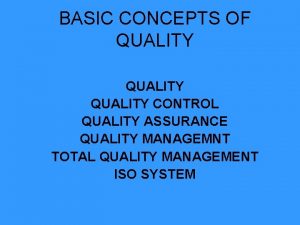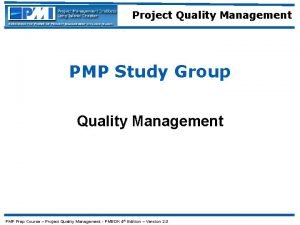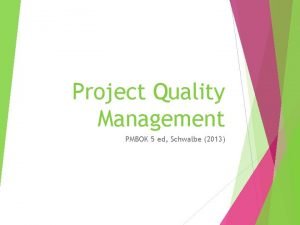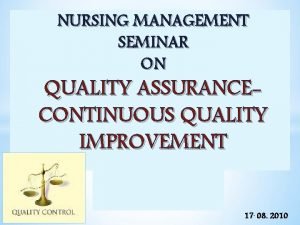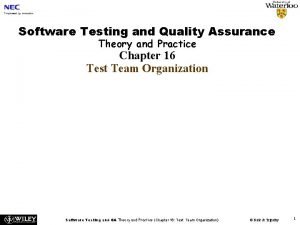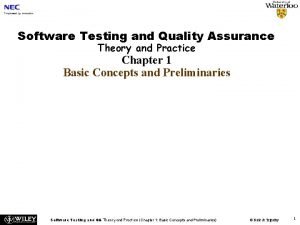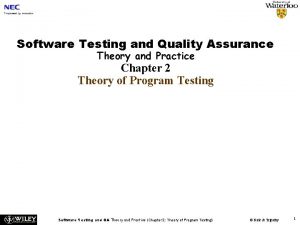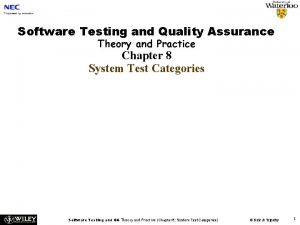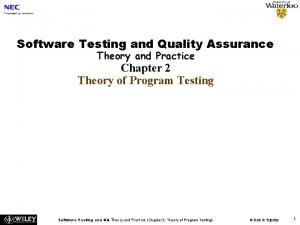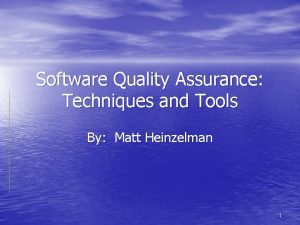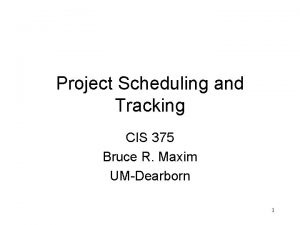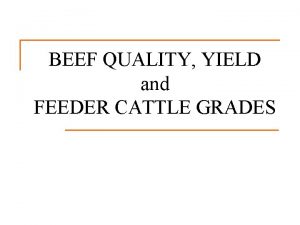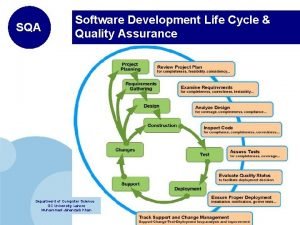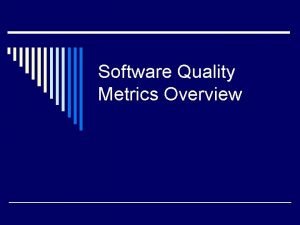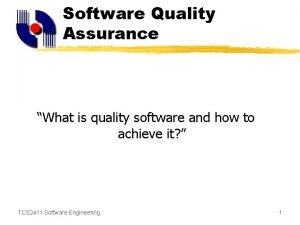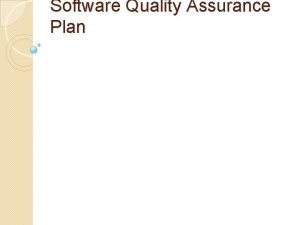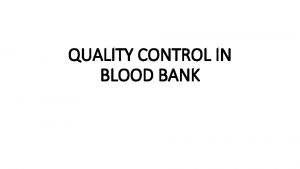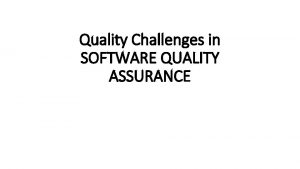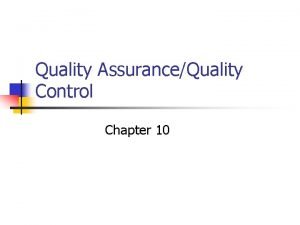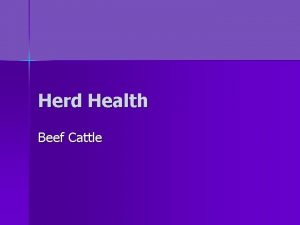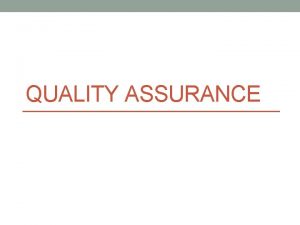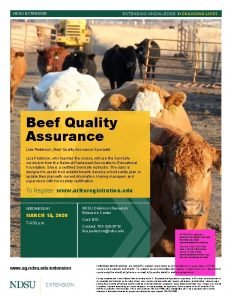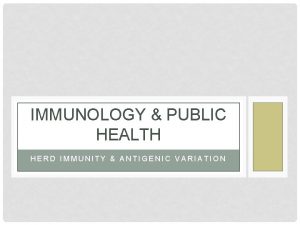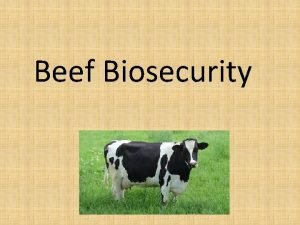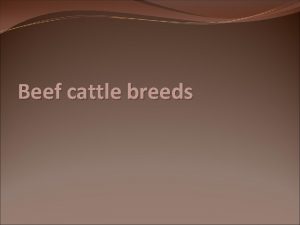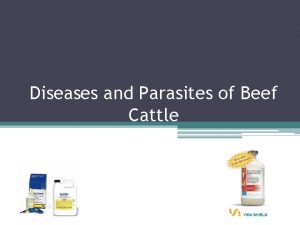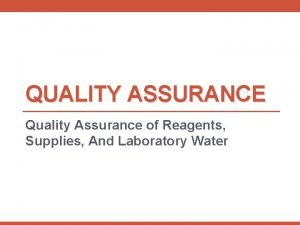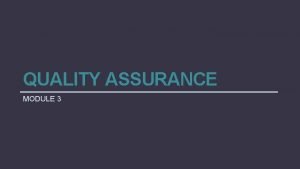Herd Health and Beef Quality Assurance SUSTAINABLE BEEF

Herd Health and Beef Quality Assurance SUSTAINABLE BEEF PRODUCTION Heidi Ward, DVM, Ph. D Assistant Professor and Veterinarian

Why Beef Quality Assurance? Ø Consumer concern about the safety of food Ø Consumer concern about animal welfare Ø Meat quality reflects the life of that animal Ø Producers can directly manage beef quality - Manage to minimize defects - Monitor health and body condition - Market in a timely manner Ø BQA provides safe and wholesome beef for the consumer!

Who is Responsible for BQA? Anyone who handles the animal from birth to adulthood to slaughter to retail are responsible for providing beef quality assurance.

Managing to Avoid Blemishes Ø Solid fences in ramps, pens and chutes so cattle only see straight ahead Ø Back off if an animal rears up in the chute Ø Never beat cattle to get them to move Ø Slope sides of the chute to reduce the animal’s ability to turn around Ø Design headgate/squeeze chute to hold the animal while treating Ø Avoid sharp edges and protruding objects that can cause bruising

Herd Health Per BQA Ø Develop a plan with a veterinarian Ø Train ALL people who work with your cattle Ø A good herd health plan will: - Improve animal health and welfare - Reduce potential for meat residues and carcass blemishes - Promote sustained profitable beef production - Decrease cost and cull rates - Reduce drug use

Goals of a Herd Health Program Ø Promote animal welfare Ø Prevent disease Ø Avoid the cost of treating disease Ø Get healthy cattle to market with a good body condition!

Aspects of a Herd Health Plan 1. Breed for health 2. Maintain a good plane of nutrition 3. Strengthen the immune system 4. Decrease parasite burden 5. Keep environment clean

Smart Breeding ♀ Ø BCS of 6. 0 at calving - Postpartum interval and colostrum quality - Colostrum contains protein, fat, sugars, vitamins A & E and antibodies Ø Vaccinate and deworm 30 days prior to breeding - Protects cow while pregnant and builds antibodies for colostrum Ø Breed heifers 2 to 3 weeks earlier than mature cows Hersom, et al. , 2015 Odde, K. G. 1997

Smart Breeding ♂ Ø BCS of 6. 0 at breeding (exercise important too!) Ø Vaccinate and deworm at least 30 days prior to breeding Ø Test new bulls for BVD and quarantine for 4 weeks Ø Trichomoniasis test on seasoned bulls Ø Breeding soundness exam 30 -60 days prior to breeding - Head to hoof exam - Semen collection for sperm count, morphology and motility

Smart Breeding Ø Pregnancy check dam for approximate calving date Ø Ensure calves are born in a clean and dry environment Ø Use plastic sleeves and clean tools when assisting calving Ø Ensure calf gets colostrum within 6 hours of birth Ø Natural colostrum is best Ø Feed 5% of BW q 8 h for 24 h Ø Monitor reproductive health post calving Ø Treat post calving infections* Ø Retain cull cows to honor withdrawal time Adapted from Besser and Gay, 1994

Maintain Nutrition Ø Provide cattle access to quality roughage and balanced ration daily Ø Evaluate ration for balanced protein, energy and nutrients Ø Check farm-raised feedstuffs for nitrates, mycotoxins and other soil or climate-induced problems Ø Throw away stale, moldy feed Ø Handle medicated feed properly and make sure withdrawal times of medications in feed are observed

Veterinary Feed Directive Ø Changes to FDA regulations concerning medicated animal feed Ø Medically necessary antibiotics cannot be used for growth promotion Ø Medically important antibiotics in feed requires veterinary oversight Ø VFD drugs do not include coccidiostats or IGRs Ø No extra-label use of VFD drugs Ø Records on VFD drugs must be kept 2 years Ø Goal is to slow down the emergence of resistant bacteria Ø Goes into full effect January 1 st, 2017 Ø More info at Beef. USA. org/antibiotics

Responsible Use of Antimicrobials Ø Select and use antibiotics carefully (based on diagnostics) Ø Avoid using antibiotics important in human medicine Ø Combination antibiotic therapy is discouraged Ø Subtherapeutic antibiotic use is discouraged Ø Treatment programs should reflect best use principles - Treat the fewest number of animals possible - Treat for the recommended time period - Avoid environmental contamination with antibiotics - Keep records of antibiotic use - Follow label directions

Strengthening Herd Immunity Ø Involves anything that impacts immune system - Maturity - Stress - Sudden change in nutrition - Vaccine status - Exposure to disease Ø Biosecurity is crucial! - Manage flow of traffic - Quickly manage illness in animals - Control pests and the environment - Disinfect everything that you can - Manage chemicals and equipment - Report any suspicious behavior - Manage/educate the employees

Strengthening Herd Immunity Ø Involves anything that impacts immune system - Maturity - Stress - Sudden change in nutrition - Exposure to disease - Vaccine status Ø Ways to boost the immune system - Feed additives - Reduce stressors - Immunization

Immunization not Vaccination! Ø Vaccines are custom to the operation (get the vet involved!) - Previous disease - Type of operation - New stock Ø Vaccine timing is very important - 3 to 4 weeks from injection to antibody protection - Maternal antibodies last approximately 2 months in calf* - Stress is an enemy to antibody production! Ø Vaccine schedule based on risk vs benefit - Calves between 2 -4 months of age - 30 days prior to expected disease - 30 days prior to breeding - 30 days prior to weaning - 30 days prior to transport

Vaccinating Properly Ø Type of vaccine is important - Modified live virus (may cause mild symptoms) - Killed virus (safer but requires an initial booster) - Bacterin (contains adjuvant and requires an initial booster) - Toxoid (contains adjuvant and is usually in a combination vaccine) Ø Administration of vaccine can be tricky - Must keep cold (never frozen) and protect from light - Never mix vaccines - Change needle often (every 10 animals minimum) - Injections should be 5 -7 inches apart - Inject in neck area (SQ always better than IM) - Use tenting method to ensure no muscle contact - If IM, no more than 10 ml per injection site

Vaccine Injection Sites

Which Vaccines? Ø Core Vaccines - IBR-BVD-PI 3 -BRSV (respiratory viruses) - Blackleg 7 -way (bacteria abundant in environment) - Lepto 5 -way (bacteria abundant in environment) - Brucellosis (required by law for heifers for transport) Ø Optional Vaccines - Scours - Pinkeye - Footrot - Anaplasmosis - Trichomonas - Tetanus - Rabies

Administer Injectables Properly Ø Sanitize equipment before and after use Ø DO NOT combine different vaccines Ø Mark and separate syringes and always use transfer needles Ø Select best route of administration (SQ over IM) Ø Choose the correct needle size Ø Mix each time before use and keep cool Ø Get air out of syringes to get accurate dose Ø Properly restrain animals prior to injecting Ø Choose the best location for the injection

Decrease Parasite Burden Ø Work with veterinarian to develop plan Ø Use only cattle approved products Ø Rotate chemical classes to reduce resistance Ø Follow instructions on label Ø Note withdrawal times Ø Dispose container according to label

External Parasite Medications

Sanitation of Environment Ø Keep feed area free of standing water, manure or other unnecessary farm items Ø Ventilate buildings to control odor and moisture Ø Provide clean, dry bedding for calving Ø Provide shade areas in the summer Ø Keep wild animals off your property Ø Observe farm biosecurity

For More Information… Ø www. bqa. org Ø www. Beef. USA. org/antibiotics Ø www. fda. gov- veterinary feed directive Ø hward@uaex. edu

Questions?
- Slides: 25

